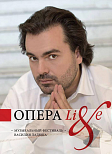| The appealing legend about the talented and noble inhabitants of the Latin Quarter of Paris inspired Henri Murger’s Scènes de la vie de bohème and made its author famous throughout Europe. Puccini’s opera is based on Murger’s novel whose characters have once and for all chosen art, creation and love… La bohème is a popular opera, a staple of the repertoire of opera houses all over the world. It is an example of verismo, which brings forward psychological feelings of the characters and scenes of everyday life. The lyrical and sentimental music of the opera often acquires a dramatic shade. The premiere performance of the opera took place on February 1, 1896 at the Teatro Regio in Turin, conducted by Arturo Toscanini. La bohème at the Novaya Opera was conducted by Italian-born maestro Fabio Mastrangelo, a connoisseur of Italian style. Georgy Isaakyan, the Intendant of the Natalia Sats Moscow State Opera and Ballet Theatre for Young Audience, will present his interpretation of this production.
“The idea of making this production at the Novaya Opera was born in a combination of internal and external circumstances. I’d been thinking about collaboration with the theatre for a long time. And occasionally I met Dmitry Sibirtsev at one of the Moscow premieres and we began to discuss possible options for our collaboration. We talked about La Bohème, and I learned that the theatre hada few perfect groups suitable for this opera and that it had been successfully performed in concert. I was delighted, because La Boheme is one of my favorite operas, moreover I can say that we are “close friends”.
The coming production is my third staging of the masterpiece. My first one took place in the 1990s (I was quite a young director at that time) and the second, in the 2000s (when I already had some experience). I hope that this version will not be the “final” one; it reflects my inner musing sand, probably, disputes with my own self. On the one hand, Puccini is one of the main composers in the history of opera, and La Bohème is a masterpiece of masterpieces, but on the other hand, I have always worked on this material with some internal antagonism. I can hardly stand Bohemianism as a way of life. To put it bluntly, I hate it. And I’m not interested at all in interpreting Puccini’s piece as it is usually done. Sympathetic tenderness, violent sobs; “poor things” endlessly sitting in cafes and telling each other about their genius, about what they would have written, painted or staged, if someone has given them money – all this is against my nature. In a traditional performance on a big stage certain things look a little bit silly. For example,the doghouse in the attic where the students huddle occupies the whole stage; huge spaces, ceilings; the characters tearing around among this endless furniture or sitting on chairs, crying “what can we light the fire with”. And all that operatic rubbish, blind spots that we take no notice of.All this external stuff has always hindered me rather than helped. To my mind, La Bohème is a deeply internal story: reflections about the artist and art, about a crisis,when you have to write but you can’t;when you can’t feel the pulse of time when you go with the stream which pushes you out again and again. Clinging to your ties with people, you hope that they can “pull you out”, but you are more likely to sacrifice these people and these ties to your crisis and to your art. Puccini’s music “warms the story up” lifting you above the kitchen sink story. In general, the external world is not the cause, but the effect. We see in it only a reflection of the internal world. That’s why the role of the“subjective camera” is so important in our production: Hartmut Shörghoferand I plays with the perspective, with a subjective view of the external world, turning it into the sky or into spiral stairs going down, into a view from the attic (from up to down) or vice versa at the Eifel tower (from the bottom upwards). Today there are heated disputes about “text” and “interpretation”. Basically, they are fruitless and most of them are started by people who have nothing to do with artistic expression. Otherwise, they would have thought about Tchaikovsky moving Pushkin’s “Eugene Onegin” to his music time and accentuating different things. Puccini did the same: he reconceived Henri Murger’s story. To begin with, the characters speak in Italian instead of French, and it creates quite a different atmosphere (because every language has its own rhythm, thought order, scent; metaphors, and emotions). The Latin Quarter in Puccini’s imagination differs a lot from Murger’s. In our production, the characters are placed in one of the most interesting, hot and even spicy aesthetics and atmospheres – Paris in the late 1940s. It was a beautiful time: death and horror were left behind and hope and new life were in prospect”. Georgy Isaakyan
 The performance on December 4, 2015 was a part of the Vasily Ladyuk’s festival OPERA LIVE (October 20–December 17) The performance on December 4, 2015 was a part of the Vasily Ladyuk’s festival OPERA LIVE (October 20–December 17)
| The La Boheme production, premiered in December of 2015, will be shown at Irish Bord Gáis Energy Theatre. The Novaya Opera’s tour will take place from November 30 to December 4, 2016. The Irish soprano Celine Byrne will perform the part of Mimi in three performances. |